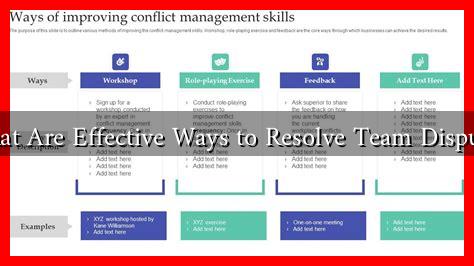-
Table of Contents
- What Are Effective Ways to Resolve Team Disputes
- Understanding the Nature of Team Disputes
- Effective Strategies for Resolving Team Disputes
- 1. Foster Open Communication
- 2. Mediation by a Neutral Party
- 3. Establish Clear Conflict Resolution Policies
- 4. Focus on Collaborative Problem-Solving
- Conclusion
What Are Effective Ways to Resolve Team Disputes
In any collaborative environment, disputes among team members are inevitable. Whether due to differing opinions, miscommunication, or conflicting work styles, unresolved conflicts can lead to decreased productivity, low morale, and even high turnover rates. Therefore, it is crucial for leaders and team members alike to understand effective strategies for resolving disputes. This article explores various methods to address and resolve team conflicts, supported by research and real-world examples.
Understanding the Nature of Team Disputes
Before diving into resolution strategies, it is essential to understand the common causes of team disputes. These may include:
- Communication Breakdown: Misunderstandings often arise from poor communication.
- Personality Clashes: Different working styles and personalities can lead to friction.
- Resource Competition: Limited resources can create a competitive atmosphere.
- Role Ambiguity: Unclear roles and responsibilities can lead to conflict.
Recognizing these underlying issues is the first step toward effective resolution.
Effective Strategies for Resolving Team Disputes
1. Foster Open Communication
Encouraging open dialogue is vital in resolving disputes. Team members should feel safe expressing their concerns without fear of retaliation. Here are some ways to promote open communication:
- Hold regular team meetings to discuss ongoing projects and any issues that may arise.
- Implement anonymous feedback tools to allow team members to voice concerns without fear.
- Encourage active listening, where team members repeat back what they’ve heard to ensure understanding.
For example, Google’s Project Aristotle highlighted the importance of psychological safety in teams, where members felt safe to take risks and express their thoughts openly.
2. Mediation by a Neutral Party
Sometimes, disputes can escalate beyond the point of self-resolution. In such cases, involving a neutral third party can help mediate the situation. This mediator can be a manager, HR representative, or an external consultant. The mediator’s role includes:
- Facilitating discussions between conflicting parties.
- Helping to identify the root causes of the dispute.
- Encouraging compromise and collaboration.
A case study from the American Arbitration Association found that mediation led to a resolution in 85% of disputes, demonstrating its effectiveness.
3. Establish Clear Conflict Resolution Policies
Having a clear set of guidelines for conflict resolution can help teams navigate disputes more effectively. These policies should include:
- Steps for reporting conflicts.
- Timelines for resolution.
- Consequences for unresolved disputes.
Organizations like the Society for Human Resource Management (SHRM) recommend that companies develop and communicate these policies to ensure everyone understands the process.
4. Focus on Collaborative Problem-Solving
Encouraging a collaborative approach to problem-solving can transform disputes into opportunities for growth. This involves:
- Identifying common goals that all parties can agree on.
- Brainstorming solutions together rather than assigning blame.
- Creating action plans that outline steps each party will take to resolve the issue.
For instance, a study published in the Journal of Conflict Resolution found that teams that engaged in collaborative problem-solving were 30% more likely to reach a satisfactory resolution than those that did not.
Conclusion
Disputes within teams are a natural part of working together, but they do not have to be detrimental. By fostering open communication, utilizing mediation, establishing clear policies, and focusing on collaborative problem-solving, teams can effectively resolve conflicts and even strengthen their relationships in the process. As organizations continue to evolve, investing in conflict resolution strategies will be essential for maintaining a productive and harmonious work environment. Remember, the goal is not just to resolve the dispute but to learn from it and improve team dynamics moving forward.
For further reading on conflict resolution strategies, you can visit SHRM’s Conflict Resolution Toolkit.

